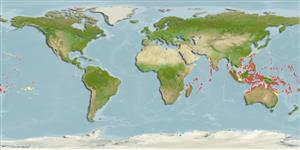Teleostei (teleosts) >
Ovalentaria/misc (Various families in series Ovalentaria) >
Plesiopidae (Roundheads) > Plesiopinae
Etymology: Plesiops: Greek, plesios = near + Greek, ops = appearance (Ref. 45335); corallicola: Specific epithet refers to the habitat of the species, a coral-dweller (Ref. 27772).
More on author: Bleeker.
Environment: milieu / climate zone / depth range / distribution range
Ecology
Marine; reef-associated; depth range 1 - 23 m (Ref. 9710), usually 1 - 10 m (Ref. 27115). Tropical; 23°C - 27°C (Ref. 130634); 32°N - 24°S
Indo-Pacific: Madagascar to the Line Islands; north to southern Japan, south to the southern Great Barrier Reef and Tonga. Throughout Micronesia.
Size / Weight / Age
Maturity: Lm ? range ? - ? cm
Max length : 18.0 cm TL male/unsexed; (Ref. 90102)
Dorsal spines (total): 12; Dorsal soft rays (total): 7 - 8; Anal spines: 3; Anal soft rays: 8. Coloration can vary from pale gray with black blotches and blue dots to an almost uniformly black except for the ever-present blue ocellus on the edge of its operculum.
Adults are benthic which occur inshore (Ref. 7300). Relatively common on reef flats, searching under rocks or in crevices for small fishes and crustaceans which serve as food (Ref. 1602). Common, but hidden in holes by day. They venture out to feed on small invertebrates and fishes at night (Ref. 9710). Apparently, gastropods form an important component of the diet as indicated by X-ray radiographs (Ref. 27772). Eggs are guarded by the male parent (Ref. 205). Aquarium breeding is possible (Ref. 130634). Minimum depth reported from Ref. 27115.
Life cycle and mating behavior
Maturity | Reproduction | Spawning | Eggs | Fecundity | Larvae
Eggs are guarded by the male parent (Ref. 205).
Mooi, R.D., 1995. Revision, phylogeny, and discussion of biology and biogeography of the fish genus Plesiops (Perciformes: Plesiopsidae). Life Sci. Contrib. No. 159, 108 p. (Ref. 27772)
IUCN Red List Status (Ref. 130435: Version 2024-2)
Threat to humans
Harmless
Human uses
Fisheries: commercial; aquarium: commercial
Tools
Special reports
Download XML
Internet sources
Estimates based on models
Preferred temperature (Ref.
123201): 26.3 - 29.3, mean 28.6 °C (based on 2693 cells).
Phylogenetic diversity index (Ref.
82804): PD
50 = 0.5000 [Uniqueness, from 0.5 = low to 2.0 = high].
Bayesian length-weight: a=0.00468 (0.00175 - 0.01251), b=3.18 (2.95 - 3.41), in cm total length, based on LWR estimates for this (Sub)family-body shape (Ref.
93245).
Trophic level (Ref.
69278): 3.7 ±0.58 se; based on food items.
Resilience (Ref.
120179): Medium, minimum population doubling time 1.4 - 4.4 years (Preliminary K or Fecundity.).
Fishing Vulnerability (Ref.
59153): Low vulnerability (10 of 100).
Nutrients (Ref.
124155): Calcium = 86.8 [46.0, 136.3] mg/100g; Iron = 0.604 [0.370, 0.980] mg/100g; Protein = 18.6 [17.5, 19.6] %; Omega3 = 0.0952 [, ] g/100g; Selenium = 24.7 [12.4, 48.8] μg/100g; VitaminA = 131 [46, 357] μg/100g; Zinc = 1.5 [1.0, 2.1] mg/100g (wet weight);
